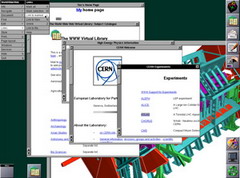




|
Design © Astra Design Company
|
History of Web DesignThe term web design implies the great range of activities such as web site planning, web site creation, web site modeling, web site designing, web site coding and programming and professional arrangement of the pages which make up a user-friendly and easy-to-use site. It is very important to pick up an appropriate design and web site programming for a specific area and to make it suitable for displaying by all web browsers in the Internet. 
We can't say that Internet has a very long history. It started its existence not very long ago but it has been developing headily and became the essential part of every person: school children, businessmen, shop managers, amateurs and housewives use the Internet every day. The history of the Internet starts in the late 1960s. First it was strictly used for US military purposes. Later some universities started using it. At that time the internet was a special tool for exchanging important data between computers with the help of transmission control protocols (TCP/IP). In 1969 the special Internet language appeared. It was ARPANET and GML (General Markup Language). The way of communication through computers was inconvenient and not user-friendly. But in the year 1972, ray Tomlinson created email which inverted the life of the Internet from feet to the head. The year 1980 became the tipping point in the Internet sphere. American National Standards Institute committee announced the working draft of Standard GML (SGML). Later the scientist of the European Organization for Nuclear Research (CERN), Tim Berners-Lee, invented the HyperText Markup language (HTML) which is widely spread nowadays and no site can exist without it. In 1989-1990, Tim Berners-Lee proposed a set of protocols and software (the first web browser and editor called World Wide Web) that allowed computers to browse the information in the Internet and developed the first web server called HyperText Transfer Protocol daemon (httpd). He was the first to combine the Internet communication with hypertext and was also responsible for the first web site which was put online in August 1991. At that time there was only one web server located in CERN, but by the end of 1992, over 50 web servers were operating in the world, primarily at the universities and research centers. 
In the beginning, web design was of the minimum, but as the Web progressed, HTML became more complex and flexible allowing users to add images and tables to web pages. With the invention of Cascading Style Sheets (CSS) and a web server technology with the ability to highly customize the response based on the user's requirements (server-side scripting), web design experienced a rapid evolution. In 1993, the first Internet browser, Mosaic - which enabled users to surf the Internet in a graphical way and opened the Web up to the general public - was released by the National Center for Supercomputing Applications (NCSA). The browser made it possible for users to view text and graphic, but within a very limited layout arrangement that influenced the ability to provide graphic design information for visual communication and restricted the abilities of web design. In 1994, W3C Consortium was founded in order to set standards and direction of future development of HTML to achieve an ability to provide dynamic content over the web. And soon after, in 1995, Microsoft released a new version of the company’s operating system, Windows 95, which featured a completely new user interface and a browser on the Windows platform, Microsoft Internet Explorer, which became very popular worldwide. A few months later, AltaVista, the first multi-lingual search engine, and Amazon.com, one of the first Internet companies to allow electronic transactions, were invented, and the World Wide Web began to grow rapidly. Database integration technologies such as server-side scripting (PHP, ASP.Net, JSP, ColdFusion, etc.) and design standards like CSS were substantially changed and provided more opportunities for web designers and web developers. With the introduction of Macromedia Flash in 1996, the technology became a popular method used to create animation, various web page components and integrate video into web pages, and further changed the face of the Internet. Though Flash enabled designers to create interactive content with minimal development knowledge, its early versions had very limited scripting capability. But in the following years Flash continued to develop, gaining a scripting language based on JavaScript and other useful features that transformed it into a full presentation development tool. And nowadays there are many web sites which forego HTML entirely for Flash ignoring the fact that multiple flash elements decelerate load time. History of web design is inconceivable without a person who has contributed much in its development and is considered to be a leading web usability consultant. His name is Jakob Nielsen. Dr. Nielsen has a computer science PhD and is very popular among web designers and web developers. His column devoted to web usability has been published in the Internet since 1995 and currently numbers more than 200,000 readers. Being called “the king of usability” (Internet Magazine) and “the guru of web page usability” (The New York Times), Jakob Nielsen has developed the main principles which make a site easy to use. He criticizes Flash, animation and large graphics and gives preferences to plain, easy-to-navigate web sites accessible to a common user of the Internet. Though Nielsen is often denounced for radical views and emphatic remarks, his teachings have gained popularity with the wider design community. History of web design can be conventionally divided into four main periods (generations) subject to the level of web site development and the complexity of site design. The first period began with the development of the first freeware browser “Mosaic” and came to the end when HTML became widespread. The design of web sites at that stage was influenced much by many technological restrictions such as slow modem connections, inability of service providers to transfer the data quickly and monochrome monitors. The websites of that time usually included headline banners and a full-page text with black lines for segmentations. In contrast to sites of the first period the websites of the second period looked more professional and had some new characteristics, including icons instead of words, buttons with chamfered edges, banners, structural menu to present a hierarchy of information and bullets. The web sites created at this stage were over-crowded with icons, colored graphics and backgrounds. Many of the site characteristics were driven by the development of technology that was constantly changing, for example, there was need to adapt site design to the certain screen resolution and to 8bit or 24bit monitors. At that time web designers began to pay attention to such a significant factor as speed of downloading information. But still web text was not easy to read because of the browser characteristics, and users were not interested in waiting a few minutes for a content to appear on the screen. Third generation web sites were developed with the main purpose to deliver the multi-media content, including sound, animation, 3D models, etc., that was in demand. This stage is associated with the introducing of Flash technology which has become very popular. Web designers used multi-media content with the aim to attract customers and visitors in accordance with the particular site's objective. Therefore, the site structure and its navigation system were considered extremely important for the site design in order to enable users to find what they are looking for quickly. The main principle of the third stage was to follow the strategy of “AIDA”, i.e., attract new visitors, hold their interest to a site for a while, arouse the desire to learn more about a site or a company, and motivate visitors to take action to respond. The fourth generation web sites tend to be similar to the sites of the previous generation with some distinctive features such as an abundance of multi-media content and unique web–driven selling propositions which can only be delivered on the Internet. Nowadays, websites are specifically developed for ecommerce, government, education, entertainment, business, etc. with the main purpose to meet the client’s requirements. 
The World Wide Web continues to grow together with the number of web users and every year millions of web sites are added to the mix. The main trends and techniques of web design change in accordance with the technological expansion and the requirements of the Internet users giving place to such factors as creativity and adequacy. History of web design is a history of the 21st century; therefore each of us has a unique opportunity to contribute to its further development. References:
|









